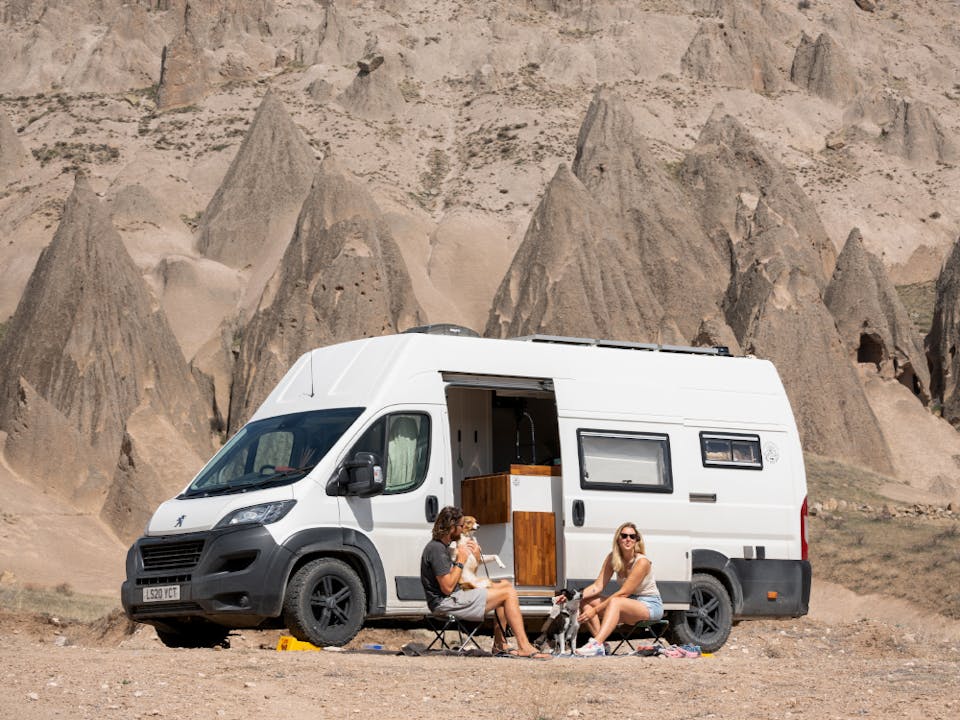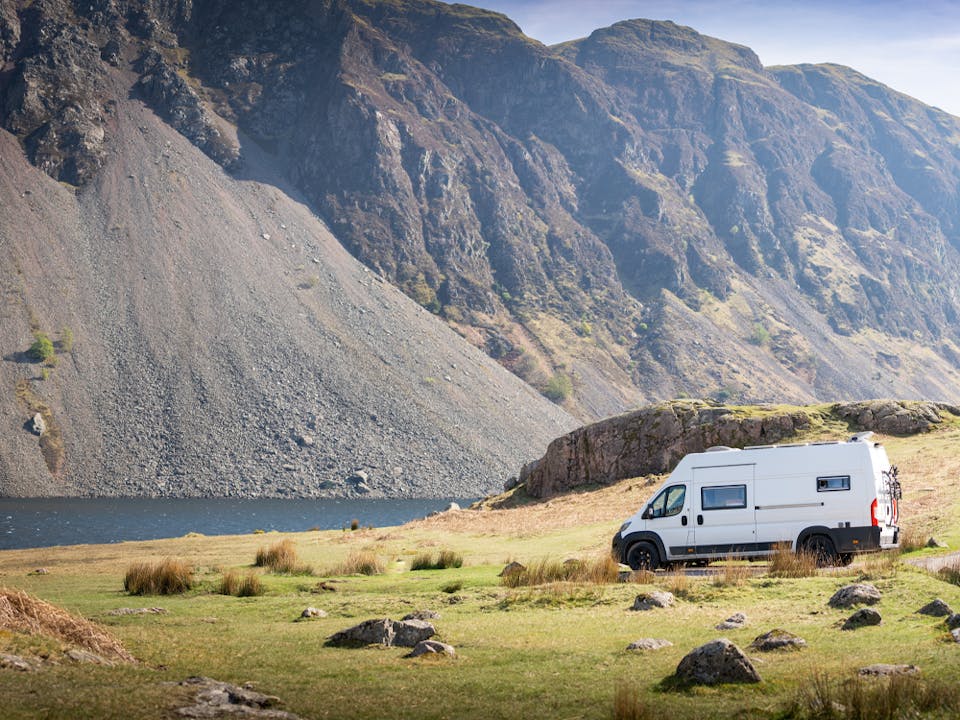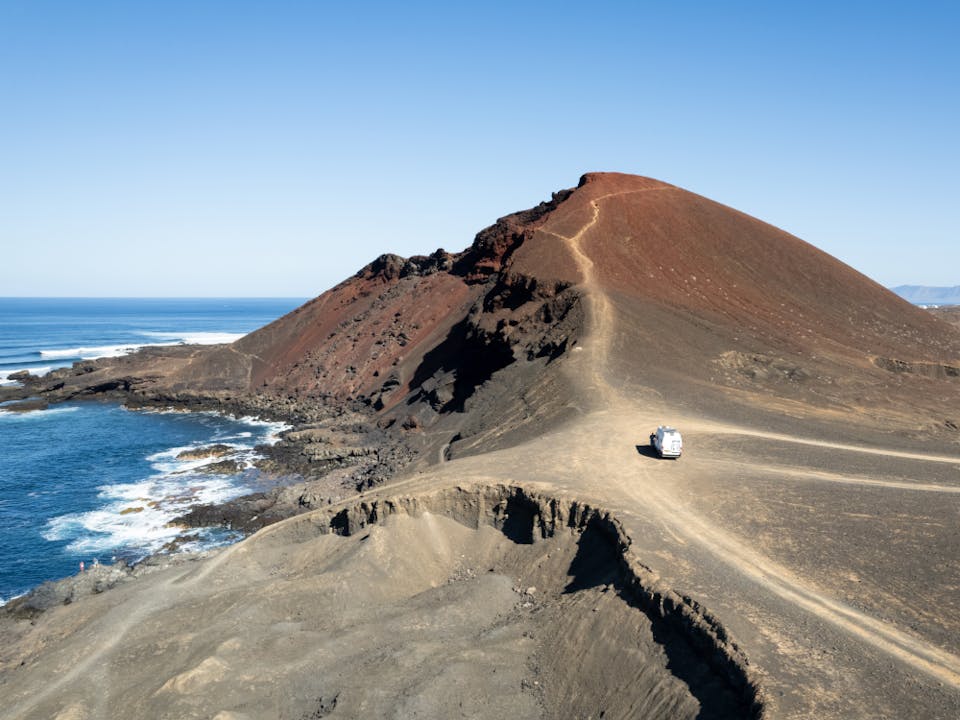
What we'd change in our van conversion, 18 months in
After living in our van conversion for 18 months, we've come up with some general conclusions on what mistakes we made during the van build, some annoyances and also bits that we would change today, or will change in future. We moved into our van fulltime in January 2022 and have spent most of our time since travelling across Europe and Türkiye. We've lived in mountains, by lakes, at the beach and in the woods from snow to 35+ degrees so our experiences are based on the above.
Changes we've already made:
Since the van was initially built we've made a couple of tweaks to increase our overall comfort and living experience in the van.
1. We added a Lagun table mount to the back of the shower room wall. This means we have an additional desk/table area which works with the passenger seat in the cab of the van. When it's not too hot out we comfortably can work from the passenger seat when it is rotated to face sideways across the cab.
2. We swapped the Truma 4E combi boiler for the Truma 6D. When we first lived in the van we were living in the UK and in the depths of winter. We were running out of LPG really quickly from the heating running and getting LPG is getting harder and harder in the UK from garages/petrol stations. We'd sometimes have to drive 40 minutes each way to find LPG. Since moving over to the Diesel version we've been far happier. The added benefit from the Diesel version is that you can just leave the thermostat on whilst driving without having to worry about open gas valves etc. That said, both the 4E and 6D have had issues and error codes - The 6D needed new glow plugs installing just months after having it fitted. In future we'd probably try one of the JP diesel equivalents of the Truma 6D and save half the cost in the process.
3. We added a second Victron Orion 30a DCDC charger. Now when the van is running or driving we can generate 60a just from the 2 DCDC chargers and gain power back into our battery banks much faster. This was especially handy over winter when solar yields were lower and we were only doing smaller drives.
The van, and external changes:
We'll start with the van itself, and any modifications. We've been very happy with our van choice. The Peugeot Boxer L4 H3 has been a fantastic size for us, it's big enough to live comfortably without being overbearing to park and we've not found many places you could take a car but not the van.
As we like to live in remote spots one aspect of the van we'd like to upgrade is the ride height. A lift kit of at least a couple of inches would go a long way in helping to mitigate hitting any of the underslung tanks or mechanical components of the van. Our water tanks, gas tank and skid pans at the front of the van have all become damaged and worn over time. We'll continue to use the BFG AT tyres as we've been pleased with their performance on and off road.
Externally we'd also like to increase our water carrying capacity, we'd easily be able to sacrifice the grey waste tank size in order to carry more fresh water. Because of where we tend to travel and using eco products within the van we rarely have to store much water in our grey waste tanks.
For the roof, we'd change having everything mounted to the van itself with lots of holes needing drilling to having everything mounted on a lightweight uni strut mount. This would enable a far more modular solution for everything from antennas to storage solutions and solar panels. If any items on the roof failed or needed replacing this would also make the task much easier. We think it would make sense to use a high-quality, weatherproofed entry gland for cables coming into the van from the roof, but allow enough space to expand additional cables to the roof if required.
In terms of our WiFi antenna, we would no longer bother with this on the roof. Since upgrading our router (to a ZTE MU5001) we've not used it since the end of 2022 and have had no issues with the connection for working. Instead, we would leave space within the rack system for an eventual satellite internet dish (like Starlink) and eventually use the 3/4/5G router for redundancy when the satellite internet isn't working.
We'd also lose the small Heki roof light over the shower, it's hot in summer, freezing in winter and we're not that impressed with the general build of it. Instead, we would prefer a simple electronic extractor vent on a humidity sensor (with the ability to force it on/off also).
The kitchen:
We opted for the Dometic CRX 80l compressor fridge in our build. In terms of power draw and general build quality we're happy with the choice but in hindsight would have gone for the 110l option for fulltime living. Although we can store enough food to last off grid for a reasonable amount of time, we never have additional space for extra bottles of water, keeping cans cold and a reserve bottle of wine unless the food is running low. Having the fridge so full after a shop also makes it harder when cooking to get what you need in and out without a 5 minute game of fridge Jenga. After experiencing some incredibly high temperatures in Greece and Italy, we'd also consider either an additional external vent at the back of the fridge to disperse heat outside of the van, or an additional internal fan system for pulling heat away from the fridge. When you live in permanently hot weather the compressor is working overtime to keep the contents of the fridge cool and this generates LOTS of heat. Enough to technically allow us to say we have a heated cutlery drawer and wardrobe above it (hot toothpaste is not nice)
We wouldn't bother with the plinth/floor running LEDs in a future van. These are rarely/never used and are also some of the least efficient lights in the van for power consumption (van floors are normally pretty dirty, you don't need bright LEDs down there to highlight it).
Although we designed our build, we outsourced the construction and it's become apparent over time that some of the material choices have not been the best. The wood within the carcasses is too soft and so things like door latches are always coming loose but there is nothing left for them to tighten into. The door fronts have also warped and bent over time which has made them apply even more stress on the latches and fittings. Gas struts have failed and things are generally out of alignment. In general, we definitely need more premium fixtures throughout the van. This is not an area you should attempt to save money on by purchasing the cheapest options. If you have any movement in any of your doors, cupboards or openings at the time of your build, it's only going to deteriorate and cause more problems after you've rattled around in the van for a while. To clarify, the precision and quality of fixtures and build materials is REALLY important.
We love the aesthetic of the wooden butcher block work tops we have but they do not hold up fantastically in an environment which is sustainable to extreme variances in temperature and humidity. They mark and stain easily and generally don't look great for very long. You can, of course, sand them back and retreat them with oil such as OSMO to preserve the look and life of the work tops, but this is not something that is very easy or practical to do when you live in your van fulltime.
The bathroom/shower room:
One of the major changes we'd make here is the general construction of the space. We'd move from plastic/fibreglass shower trays to a solid wet room system.
- See the Lokitravelbox blog for a fantastic example of a wetroom build.
- See Thewholeworldornothing for a great van wetroom build guide.
After having two trays crack and numerous repairs we are pretty 'done' using these and would never suggest using one in your own builds. The additional benefit of having a wetroom style build is that it would increase the internal footprint of the shower room and give us some additional space to stand.
We could also have a proper angle on the floor to ensure water flows towards the drain as you're rarely parked totally flat living in a van. A decent shower trap is also something we'd like to stop any smells from the grey water tank coming back into the van.
As mentioned above we'd also remove the Heki skylight in our bathroom in favour of an electric extractor. We'd either separate the lighting from our main circuit with its own switch just for the showroom or add a motion sensor to control the light inside.
We'd keep the same wall panel types, shower system, Natureshead toilet, heating vent and other aspects of the shower room.
The bedroom:
Looking at the cabinets over our feet from outside of the van you can see a fairly decent gap between the end of the cabinet and the rear doors of the van. We'd like to have a shelf added here which is wide enough to take a couple of hot drinks and with enough space above it to store our water bottles whilst in bed. For now, we've got some temporary acrylic ones in place that have been stuck on rather than screwed in so they can be removed without causing any damage.
This one is technically the cab, but it affects sleeping. We have a normal house-style curtain rail and curtain between the cab and the back of the van. It hangs freely at the sides so you get gaps of light coming in. As well as having something to fix/secure the curtain to at the edges we'd also like to upgrade the curtain itself to something with better thermal properties to try and keep it warmer in winter, and cooler in summer.
We have absolutely no regrets about our bed size, although any extra length would be lovely the width is that of a king. We definitely wouldn't have coped with a double in the back.
The electrics:
One of the biggest investments in any van conversion or motorhome is the electrical setup and capability. At the time our van was built it seemed to have a larger than average power setup, but things have changed in the last couple of years and there are more powerful batteries and chargers on the market.
We currently have 360ah of lithium batteries between 2 x 180ah. If building the van again or upgrading our setup we would go for a minimum of a single 460ah, likely a Roamer battery as they are the evolution of where our original batteries came from. You may think that this seems like a lot of power, but when you live off grid and don't rely on other power sources it's important to have what you need, plus some redundancy. For example, in summer in Greece running 2 x MaxxAir fans, the Truma on vent mode and all the other regular power consumption (fridge / charging devices etc) overnight can draw 80a alone. This is easily recooperated early in the day by solar but that restricts you to parking in the sun which is counterproductive to trying to keep the van cool. We can comfortably go for 4 days under trees without moving or solar, but would like to extend this.
Our solar setup consists of 3 x 180w panels (540w total) and we would love to have an additional 180w or a generally increased amount for power regeneration if it would fit on the roof. There are likely more powerful/efficient panels on the market now which could allow this.
Our 3000w inverter has been OK, but we leave it on 100% of the time as the remote function became a bit flakey. We'd now opt for a Victron Multiplus 3000w system which is an inverter and battery charger. The rest of our setup is already Victron and we've had no issues with the performance of any of it.
Thanks to the Victron GX, monitoring all of your van's temperatures, electrical system and gas/water levels is now possible. We'd 100% add one of these, and the Cerbo which allows remote access into the setup.
To keep the electrics cool, we'd add additional venting and potentially even automatic fans on heat sensors around the bulk of the components. Between the inverter and the 2 x Orions, the cupboard in which everything is housed can get very hot whilst living in hot climates.
Since adding the table to the cab we've missed having a 240v double socket at that end of the van. We currently have to run an extension cable from the seating area to the front of the van if we want to charge and work in the front so we'd love to have one added. Another great addition to the cab would be an additional 12v cigarette style socket in the blank which is next to the existing one in the Boxer/Ducato/Relay/Master vans. We'd have this wired up to the leisure batteries so we can always charge items in the front of the van.
In winter, and when arriving at park ups in the dark (which we do try to avoid) the standard vehicle lights aren't always bright enough, especially if you need to reverse. We'd like to have some additional external lighting on the front and back of the van which can be controlled from the cab manually.
We'd love to be able to install a 12v air conditioning unit also but we think the feasibility of getting this to work off grid in this size van would be a challenge. We'd need to massively increase our battery capacity (around 900ah+) but also our solar setup in order to regenerate the electricity required. It would be a huge expense for potentially minimal gains for us vs driving to cooler climates during the peak of summer.
Our last addition to the van which would require some additional consideration and wiring would be an external CCTV system. We would love to have a 360 view of the exterior of the van and have remote access to this feed from our phone.
The garage:
The garage area has been working well for us, it's held up well to general wear and we store A LOT in there so it's always taking a bit of a beating getting gear in and out.
One annoyance for us is that in winter, the light switch for the garage is on the left side, this means you have to open both the rear doors to get to the switch. This would have been much better placed on the right side of the vehicle.
The wood panelling on the wood doors is also the same from the floor to the ceiling. We'd probably put a harder wearing material on the lower half of the door, or at least coat it in the same raptor paint as the rest of the garage to give it a bit more durability.
Conclusion:
We hope you've found some of our learnings useful, and would love to hear from you if you've drawn to any of the same, or different conclusions from time in your own van or motorhome. Likewise, if you have any product suggestions which you think could answer some of our 'wish list' items we'd appreciate a message. We spent a long time researching the layout and general specifications of our van and for the most part we feel like this has really paid off. Of course there are some small tweaks that you really only learn or understand from time living on the road full time. Hopefully this post hasn't come across too negative, we have tried to be as constructive as possible in our writing and truly love both the van, and living in it!
For some more context around our layout and van design you can see it in the below video. This was filmed a year ago before we made some of the above-mentioned changes. It was also shot prior to leaving the UK. We have longer hair now and the whites aren't quite so white 😂



